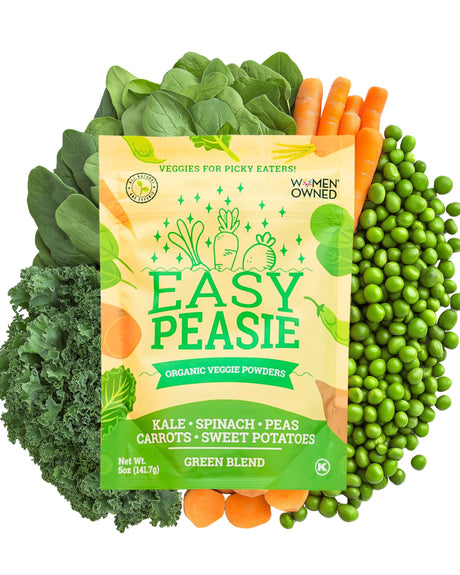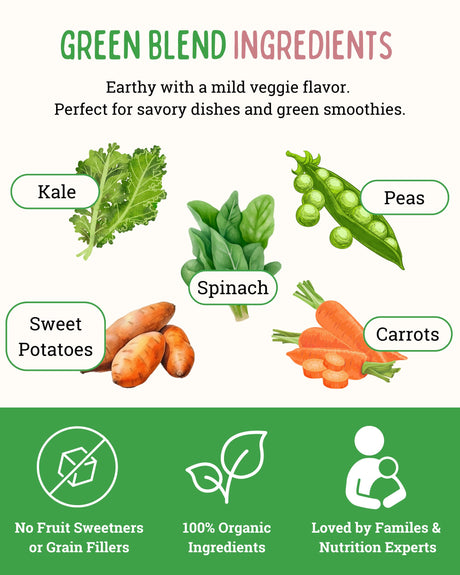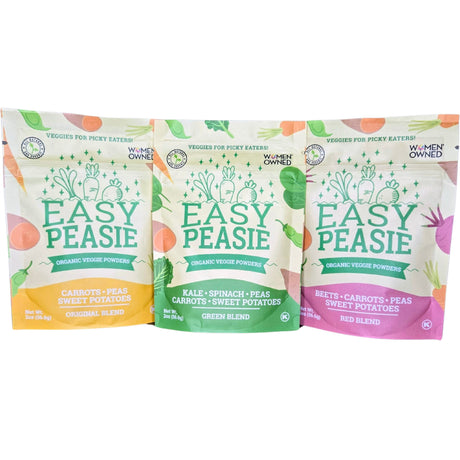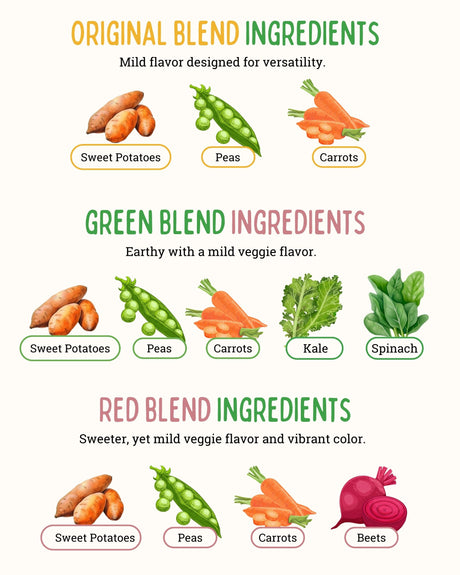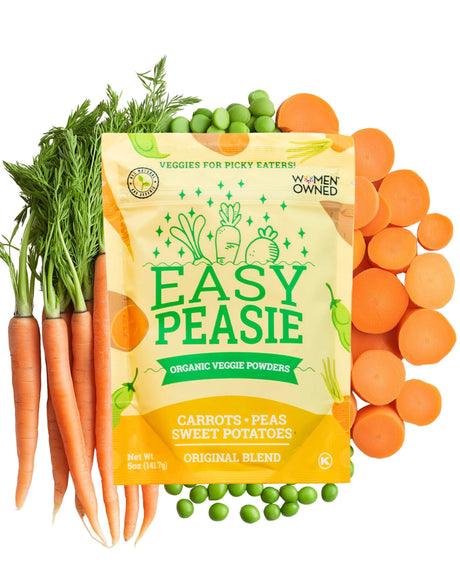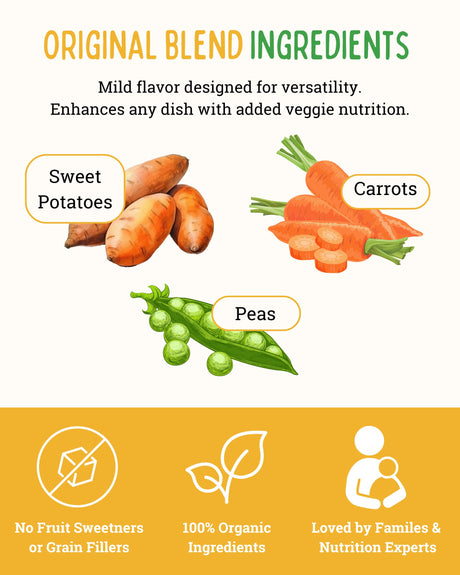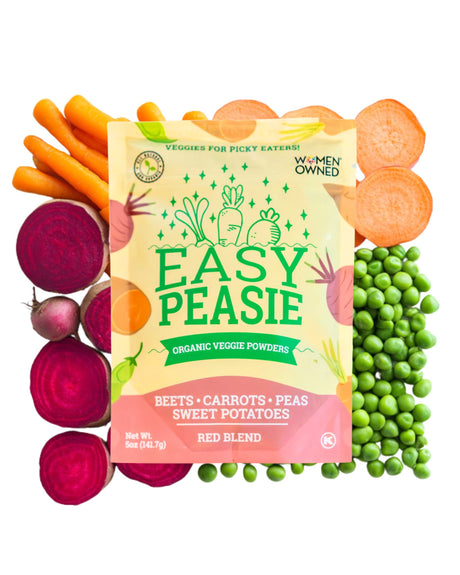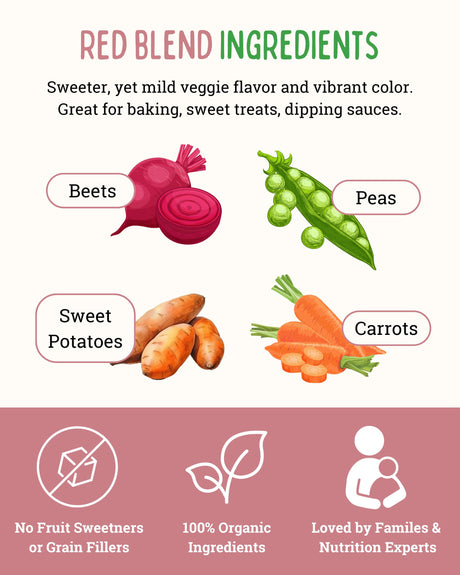Vegetables play a vital role in promoting optimal health in children. They provide essential nutrients that are necessary for their growth and development, including vitamins A, C, and K, folate, potassium, and fiber. These nutrients support various bodily functions, such as strengthening the immune system, promoting healthy digestion, and maintaining healthy bones and teeth.
Introducing Veggies
Introducing children to a wide variety of vegetables from a young age is key to fostering healthy eating habits that can last a lifetime. However, getting kids to eat their vegetables can sometimes be a challenge, especially when they are presented in unfamiliar or unappealing ways. That's where kid-friendly veggie burgers come in!
The goal of this blog is to provide parents with a delicious and nutritious recipe for veggie burgers that are specifically designed to appeal to kids' taste preferences.
By making veggie burgers fun, flavorful, and visually appealing, we aim to encourage children to embrace vegetables as an enjoyable and essential part of their diet. So, let's dive into the world of kid-friendly veggie burgers and discover how to create a meal that both parents and children will love.
Benefits of Veggie Burgers for Kids

Nutritional Benefits
Veggie burgers offer a wide array of nutritional benefits that make them a wholesome choice for kids. Compared to traditional beef burgers, veggie burgers are typically lower in saturated fat and cholesterol, making them heart-healthier options. They are also packed with fiber, vitamins, and minerals, thanks to the abundance of vegetables and plant-based ingredients they contain. These nutrients are essential for children's growth and development, supporting overall health and well-being.
Introduction to Variety
Introducing kids to veggie burgers is an excellent way to expose them to a diverse range of vegetables and plant-based foods. By incorporating various veggies into the burger patties, such as carrots, spinach, or mushrooms, parents can introduce new flavors and textures to their children's diets. This exposure to a variety of plant-based ingredients helps broaden their palate and encourages them to embrace a more diverse and nutritious diet.
Health Implications
Encouraging kids to consume more plant-based foods, such as veggie burgers, can have significant health benefits. Research suggests that reducing meat consumption and opting for plant-based alternatives may lower the risk of chronic diseases, such as heart disease, obesity, and type 2 diabetes, later in life. By incorporating veggie burgers into their meals, parents can help instill healthy eating habits in their children and promote long-term wellness.
Key Ingredients for Kid-Friendly Veggie Burgers

Essential Ingredients
The veggie burger recipe requires a handful of essential ingredients to create flavorful and nutritious patties. These typically include cooked beans or lentils as the base, which provide protein and fiber, along with binding agents like breadcrumbs or oats to hold the patties together. Additionally, a variety of vegetables, such as onions, bell peppers, and carrots, are finely chopped and mixed into the patties to add texture, flavor, and a boost of vitamins and minerals.
Nutritional Value
Each ingredient in the veggie burger recipe contributes to a balanced meal, providing essential nutrients that support children's health. Beans and lentils are excellent sources of plant-based protein, fiber, and complex carbohydrates, which help keep kids feeling full and satisfied. Vegetables add an array of vitamins and minerals, including vitamin C, vitamin A, and potassium, which are vital for growth, immune function, and overall well-being. Whole grains like breadcrumbs or oats offer additional fiber and micronutrients, completing the nutritional profile of the veggie burgers.
Alternative Ingredients
To accommodate dietary preferences or restrictions, there are several alternative ingredients that can be used in the veggie burger recipe. For example, gluten-free breadcrumbs or rolled oats can replace traditional breadcrumbs for those with gluten sensitivities. Likewise, tofu or tempeh can be substituted for beans or lentils to create a soy-based version of the patties. Additionally, a variety of vegetables can be incorporated based on personal taste preferences or seasonal availability, allowing for flexibility and customization in the recipe.
Step-by-Step Recipe Instructions
Preparing the Veggie Burger Patties

To prepare the veggie burger patties, start by draining and rinsing the cooked beans or lentils to remove excess moisture. In a large mixing bowl, mash the beans or lentils using a fork or potato masher until they reach a chunky consistency. Add finely chopped vegetables, such as onions, bell peppers, and carrots, along with minced garlic and your choice of seasonings like paprika, cumin, or dried herbs.
Mix in binding agents like breadcrumbs or oats to help hold the patties together, adjusting the amount as needed to achieve the desired texture. Finally, use clean hands to shape the mixture into evenly sized patties, ensuring they are compact and hold their shape well.
Cooking Methods

- Grill: Preheat an outdoor grill or grill pan over medium heat. Lightly brush the grill grates with oil to prevent sticking. Cook the veggie burger patties for 4-5 minutes per side, or until golden brown and heated through.
- Bake: Preheat the oven to 375°F (190°C). Place the patties on a parchment-lined baking sheet and bake for 20-25 minutes, flipping halfway through, until crisp and browned on both sides.
- Pan-Fry: Heat a non-stick skillet or frying pan over medium heat. Add a small amount of oil and carefully place the patties in the pan. Cook for 3-4 minutes per side, or until golden and crispy.
Assembling and Serving
- Prepare the Buns: Toast whole-grain burger buns until golden brown. Spread with your choice of condiments, such as mustard, ketchup, or hummus.
- Building the Burgers: Place a cooked veggie burger patty on each bun. Top with sliced tomatoes, lettuce, avocado, or other preferred toppings to add flavor and texture.
- Completing the Meal: Serve the veggie burgers alongside oven-baked sweet potato fries, fresh fruit salad, or a side of crunchy raw veggies for a well-rounded and nutritious meal.
- Kid-Friendly Touches: To make the meal more appealing to children, consider shaping the veggie burger patties into fun shapes like stars or hearts. Alternatively, involve kids in the process by letting them assemble their own burgers with their favorite toppings.
Adding Kid-Friendly Flavors and Textures
When it comes to making veggie burgers appealing to kids, incorporating familiar flavors and textures can make all the difference. Consider adding ingredients like shredded cheese, cooked quinoa, or finely chopped mushrooms to the burger mixture for added flavor and texture that kids will love. Additionally, adding a touch of sweetness with ingredients like grated carrots or diced sweet potatoes can help balance out the savory flavors and appeal to younger palates.
Sneaking in Extra Vegetables
One of the great things about veggie burgers is that they provide an excellent opportunity to sneak extra vegetables into your child's diet without them even realizing it. Try mixing finely grated zucchini, spinach, or bell peppers into the burger mixture for an extra boost of nutrition. These vegetables not only add moisture and flavor to the patties but also contribute essential vitamins and minerals to your child's diet.
Kid-Friendly Sides and Toppings
To complete the meal and make it more appealing to kids, consider serving the veggie burgers with kid-friendly sides and toppings. Oven-baked sweet potato fries, crispy carrot sticks, or apple slices with peanut butter are all nutritious options that pair well with veggie burgers. Additionally, offering a variety of toppings like sliced avocado, tomato, lettuce, and cheese allows children to customize their burgers to their liking, making mealtime more enjoyable and interactive.
Nutritional Content of Veggie Burgers
Veggie burgers offer a nutritional powerhouse for kids, boasting a blend of essential nutrients vital for their growth and development. These burgers are typically rich in plant-based protein, sourced from ingredients like beans, lentils, chickpeas, or tofu, providing a satisfying and wholesome alternative to meat-based burgers.
Furthermore, they are packed with dietary fiber, which supports digestive health and helps regulate blood sugar levels, contributing to sustained energy throughout the day. Additionally, veggie burgers contain a plethora of vitamins and minerals, such as vitamin C, vitamin K, iron, and folate, which are crucial for maintaining optimal health in children.
Homemade vs. Store-Bought Options
When it comes to veggie burgers, the choice between homemade and store-bought options can significantly impact their nutritional value. Homemade veggie burgers offer the advantage of complete control over ingredients, allowing parents to select wholesome and nutritious components without added preservatives or excessive sodium.
On the other hand, many store-bought veggie burgers may contain additives, fillers, and high levels of sodium to enhance flavor and extend shelf life. By preparing veggie burgers at home, parents can ensure that their children enjoy a healthier and more nutrient-dense meal.
Incorporating Veggie Burgers into a Balanced Diet
To maximize the nutritional benefits of veggie burgers for kids, it's essential to integrate them into a well-balanced diet that encompasses a variety of food groups. Pairing veggie burgers with whole-grain buns or wraps adds fiber and complex carbohydrates to the meal, promoting satiety and stable blood sugar levels.
Accompanying them with a colorful assortment of vegetables, such as leafy greens, sliced tomatoes, or avocado, further enhances the nutrient profile of the meal, providing essential vitamins, minerals, and antioxidants. Additionally, serving veggie burgers alongside a side of fresh fruit or a small salad ensures a well-rounded and nutritious dining experience for children, supporting their overall health and well-being.
Strategies for Encouraging Picky Eaters
Picky eaters can present a challenge when introducing new foods like veggie burgers. One effective strategy is to involve children in the cooking process, allowing them to take ownership of their meal. When kids feel invested in the preparation, they're more likely to be curious and willing to taste the final product.
Additionally, incorporating familiar flavors into veggie burgers, such as cheese or mild spices, can help ease the transition for hesitant eaters. Gradually introducing veggie burgers alongside familiar foods during meals can also increase acceptance over time.
Tips for Making Veggie Burgers Appealing
To make veggie burgers more enticing to kids who are resistant to trying new foods, consider focusing on texture and presentation. Creating mini veggie burger sliders or shaping patties into fun shapes like stars or hearts can make mealtime more engaging for children.
Experimenting with different cooking methods, such as baking or grilling, can also alter the texture and enhance the taste, making veggie burgers more appealing. Additionally, involving kids in the meal preparation process and allowing them to choose their toppings can give them a sense of control and autonomy.
Fostering a Positive Attitude Towards Vegetables
Parents play a vital role in shaping their children's attitudes towards vegetables and plant-based foods. It's essential to create a positive food environment at home by regularly offering a variety of vegetables and incorporating them into family meals. Encouraging children to explore new foods without pressure or coercion can help them develop a more adventurous palate.
Modeling healthy eating habits and expressing enthusiasm for nutritious foods can also influence children's attitudes and behaviors towards vegetables. By making mealtimes enjoyable and stress-free, parents can foster a positive relationship with vegetables and plant-based options.
Recommendations for Storing Leftover Veggie Burgers
After cooking a batch of veggie burgers, it's essential to store any leftovers properly to maintain their freshness and flavor. Allow the cooked patties to cool completely before transferring them to an airtight container or resealable plastic bag. Refrigerate the leftover veggie burgers promptly, ensuring they are stored at or below 40°F (4°C) to prevent bacterial growth.
When stored correctly, leftover veggie burgers can typically stay fresh in the refrigerator for up to 3-4 days.
Instructions for Freezing Veggie Burger Patties
Freezing veggie burger patties is an excellent way to extend their shelf life and have convenient meals on hand for busy days. To freeze veggie burger patties, place them in a single layer on a baking sheet lined with parchment paper or plastic wrap.
Ensure there is space between each patty to prevent them from sticking together. Place the baking sheet in the freezer and allow the patties to freeze completely, usually for about 1-2 hours. Once frozen solid, transfer the veggie burger patties to a freezer-safe bag or container, removing as much air as possible before sealing.
Tips for Reheating Frozen Veggie Burgers
When reheating frozen veggie burgers, it's essential to use gentle heat to prevent them from becoming dry or overcooked. One method is to thaw the patties overnight in the refrigerator before reheating them. Alternatively, you can reheat the frozen veggie burgers directly from the freezer.
To do so, preheat your oven to 350°F (175°C) and place the frozen patties on a baking sheet lined with parchment paper. Bake for 15-20 minutes, flipping halfway through, until the patties are heated through and crispy on the outside. Another option is to reheat the frozen veggie burgers in a non-stick skillet over medium heat, cooking for 5-7 minutes on each side until warmed through. Avoid using high heat, as it can cause the patties to burn or become too dry.
Summary
In this blog, we explored the wonderful world of kid-friendly veggie burgers, highlighting their nutritional benefits, versatility, and appeal to even the pickiest of eaters. We discussed the importance of incorporating vegetables into children's diets and how veggie burgers can serve as a tasty and nutritious option.
Benefits of Veggie Burgers for Kids
Veggie burgers offer a plethora of benefits for kids, including being packed with essential nutrients like fiber, vitamins, and minerals. They provide a convenient way to introduce a variety of vegetables into children's diets, promoting a love for plant-based foods from an early age.
By reducing meat consumption and incorporating more plant-based options, kids can enjoy improved health outcomes and develop lifelong healthy eating habits.
We hope this article has inspired you to try our delicious recipe for kid-friendly veggie burgers with your family. By involving kids in the cooking process and serving the burgers with fun and flavorful toppings, you can make mealtime enjoyable and nutritious for the whole family.
So, grab your apron and head to the kitchen to whip up a batch of these scrumptious veggie burgers. Your taste buds and your health will thank you!
Leave your comments below; we love to hear from you! And don't forget to follow EasyPeasie for more veggie info and convo on YouTube, Facebook, and Instagram! ~ThePeas


